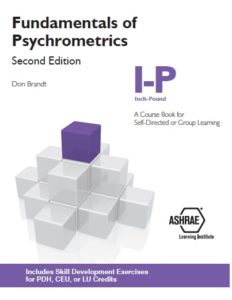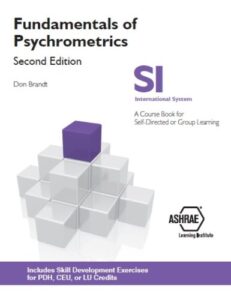ASHRAE Fundamentals of Psychrometrics SI and IP, 2nd edition
ASHRAE Fundamentals of Psychrometrics SI and IP, 2nd edition
ASHRAE Fundamentals of Psychrometrics SI and IP, 2nd edition You will develop an understanding of the basic concepts of psychrometrics including moist air properties, evaporation, enthalpy, and temperature change, plus the basic HVAC processes. After completing the course, you should know how to: use a psychrometric chart; properly design an HVAC system based on psychrometric principles; conduct a psychrometric analysis of HVAC components such as air handling units, heating and cooling coils, humidifiers and de humidifiers; evaluate the needs of individual spaces within a building; and determine energy reduction opportunities for HVAC systems.

- You will also learn about s few of both special HVAC systems and the psychrometric analysis that is required to understand these systems, plus design suggestions these special systems.
- testing at end of each section with Skill Development Exercises so you can truly feel confident about your progress and understanding of the presented material.
You can read also Fundamentals of Air System Design 2010 SI Edition
ASHRAE Fundamentals of Psychrometrics SI and IP, 2nd edition, 2nd edition Course Content
- Introduction to Psychrometrics
Understand the concept of temperature change, moisture change, enthalpy and the volumetric airflow equations and calculations also.
- Properties of Moist Air
The nature of air-water mixtures, indicators of moisture concentration in air, and the 8 properties that we use in psychrometric analysis.
- Introducing the Psychrometric Chart
How we create the psychrometric chart from the thermodynamic properties of moist air tables and scale for the eight different properties.
- Air Conditioning Processes on the Psychrometric Chart
We define both sensible and latent heating and cooling plus plot each process on the psychrometric chart.
- Psychrometric Analysis for HVAC Design
Schematic of an air-conditioning system, mixing air streams, designing with sensible heat ratio for cooling, also introduction of outdoor air for ventilation.
- Psychrometric in HVAC Equipment
The air handling unit, psychrometrics of cooling and heating coils, humidification equipment, temperature rise due to fans, and designing with the same heating/cooling CFM
- Psychrometrics in Zoned HVAC Systems
In depth look at the psychrometrics of all the common constant air volume and common variable air volume systems. Both heating and cooling are explored.
- Energy Conservation and Psychrometrics
What the psychrometric chart shows about heat recovery, energy recovery, water and airside economizers, and supply air temperature reset also.
- Special Applications and Psychrometric Considerations
An in depth look at airflow through a cooling tower, indoor swimming pool design, Clean room or Clean Space design, and both direct and indirect evaporative cooling applications
- Appendix tables
Thermodynamic Properties of Moist Air, Unit Conversion Factors, also World Climatic Design Information and Thermodynamic Properties of Water at Saturation.

Comments are closed.